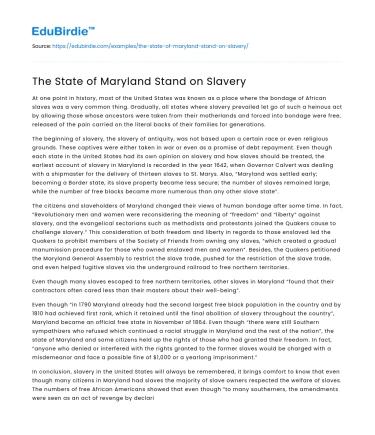At one point in history, most of the United States was known as a place where the bondage of African slaves was a very common thing. Gradually, all states where slavery prevailed let go of such a heinous act by allowing those whose ancestors were taken from their motherlands and forced into bondage were free, released of the pain carried on the literal backs of their families for generations.
The beginning of slavery, the slavery of antiquity, was not based upon a certain race or even religious grounds. These captives were either taken in war or even as a promise of debt repayment. Even though each state in the United States had its own opinion on slavery and how slaves should be treated, the earliest account of slavery in Maryland is recorded in the year 1642, when Governor Calvert was dealing with a shipmaster for the delivery of thirteen slaves to St. Marys. Also, “Maryland was settled early; becoming a Border state, its slave property became less secure; the number of slaves remained large, while the number of free blacks became more numerous than any other slave state”.
Save your time!
We can take care of your essay
- Proper editing and formatting
- Free revision, title page, and bibliography
- Flexible prices and money-back guarantee
The citizens and slaveholders of Maryland changed their views of human bondage after some time. In fact, “Revolutionary men and women were reconsidering the meaning of “freedom” and “liberty” against slavery, and the evangelical sectarians such as methodists and protestants joined the Quakers cause to challenge slavery.” This consideration of both freedom and liberty in regards to those enslaved led the Quakers to prohibit members of the Society of Friends from owning any slaves, “which created a gradual manumission procedure for those who owned enslaved men and women”. Besides, the Quakers petitioned the Maryland General Assembly to restrict the slave trade, pushed for the restriction of the slave trade, and even helped fugitive slaves via the underground railroad to free northern territories.
Even though many slaves escaped to free northern territories, other slaves in Maryland “found that their contractors often cared less than their masters about their well-being”.
Even though “in 1790 Maryland already had the second largest free black population in the country and by 1810 had achieved first rank, which it retained until the final abolition of slavery throughout the country”, Maryland became an official free state in November of 1864. Even though “there were still Southern sympathizers who refused which continued a racial struggle in Maryland and the rest of the nation”, the state of Maryland and some citizens held up the rights of those who had granted their freedom. In fact, “anyone who denied or interfered with the rights granted to the former slaves would be charged with a misdemeanor and face a possible fine of $1,000 or a yearlong imprisonment.”
In conclusion, slavery in the United States will always be remembered, it brings comfort to know that even though many citizens in Maryland had slaves the majority of slave owners respected the welfare of slaves. The numbers of free African Americans showed that even though “to many southerners, the amendments were seen as an act of revenge by declaring the enslaved free and giving them certain rights and there were many who found ways of denying free blacks those rights”, the majority of Maryland certainly thought that slavery was heinous and a person, no matter where they are from nor what their background is, should have the right to live as they chose.






 Stuck on your essay?
Stuck on your essay?

